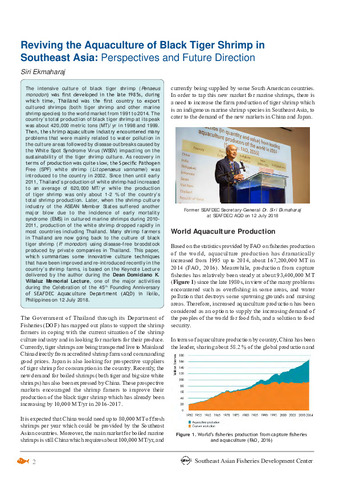| dc.description.abstract | The intensive culture of black tiger shrimp (Penaeus monodon) was first developed in the late 1985s, during which time, Thailand was the first country to export cultured shrimps (both tiger shrimp and other marine shrimp species) to the world market from 1991 to 2014. The country’s total production of black tiger shrimp at its peak was about 420,000 metric tons (MT)/yr in 1998 and 1999. Then, the shrimp aquaculture industry encountered many problems that were mainly related to water pollution in the culture areas followed by disease outbreaks caused by the White Spot Syndrome Virus (WSSV) impacting on the sustainability of the tiger shrimp culture. As recovery in terms of production was quite slow, the Specific Pathogen Free (SPF) white shrimp (Litopenaeus vannamei) was introduced to the country in 2002. Since then until early 2011, Thailand’s production of white shrimp had increased to an average of 620,000 MT/yr while the production of tiger shrimp was only about 1-2 % of the country’s total shrimp production. Later, when the shrimp culture industry of the ASEAN Member States suffered another major blow due to the incidence of early mortality syndrome (EMS) in cultured marine shrimps during 2010-2011, production of the white shrimp dropped rapidly in most countries including Thailand. Many shrimp farmers in Thailand are now going back to the culture of black tiger shrimp (P. monodon) using disease-free broodstock produced by private companies in Thailand. This paper, which summarizes some innovative culture techniques that have been improved and re-introduced recently in the country’s shrimp farms, is based on the Keynote Lecture delivered by the author during the Dean Domiciano K. Villaluz Memorial Lecture, one of the major activities during the Celebration of the 45th Founding Anniversary of SEAFDEC Aquaculture Department (AQD) in Iloilo, Philippines on 12 July 2018. | en |

